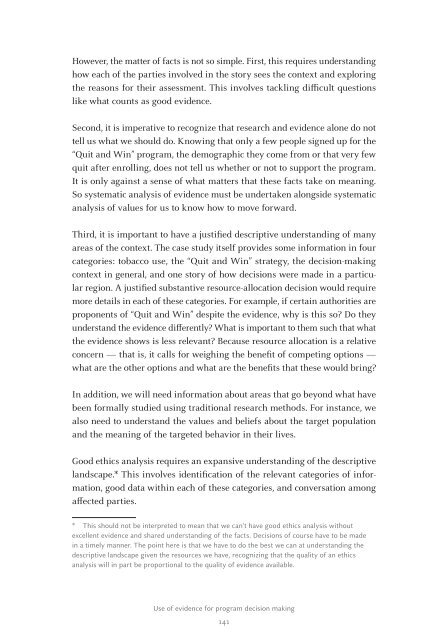PoPulationand Public HealtH etHics
PoPulationand Public HealtH etHics
PoPulationand Public HealtH etHics
Create successful ePaper yourself
Turn your PDF publications into a flip-book with our unique Google optimized e-Paper software.
However, the matter of facts is not so simple. First, this requires understanding<br />
how each of the parties involved in the story sees the context and exploring<br />
the reasons for their assessment. This involves tackling difficult questions<br />
like what counts as good evidence.<br />
Second, it is imperative to recognize that research and evidence alone do not<br />
tell us what we should do. Knowing that only a few people signed up for the<br />
“Quit and Win” program, the demographic they come from or that very few<br />
quit after enrolling, does not tell us whether or not to support the program.<br />
It is only against a sense of what matters that these facts take on meaning.<br />
So systematic analysis of evidence must be undertaken alongside systematic<br />
analysis of values for us to know how to move forward.<br />
Third, it is important to have a justified descriptive understanding of many<br />
areas of the context. The case study itself provides some information in four<br />
categories: tobacco use, the “Quit and Win” strategy, the decision-making<br />
context in general, and one story of how decisions were made in a particular<br />
region. A justified substantive resource-allocation decision would require<br />
more details in each of these categories. For example, if certain authorities are<br />
proponents of “Quit and Win” despite the evidence, why is this so? Do they<br />
understand the evidence differently? What is important to them such that what<br />
the evidence shows is less relevant? Because resource allocation is a relative<br />
concern — that is, it calls for weighing the benefit of competing options —<br />
what are the other options and what are the benefits that these would bring?<br />
In addition, we will need information about areas that go beyond what have<br />
been formally studied using traditional research methods. For instance, we<br />
also need to understand the values and beliefs about the target population<br />
and the meaning of the targeted behavior in their lives.<br />
Good ethics analysis requires an expansive understanding of the descriptive<br />
landscape.* This involves identification of the relevant categories of information,<br />
good data within each of these categories, and conversation among<br />
affected parties.<br />
* This should not be interpreted to mean that we can’t have good ethics analysis without<br />
excellent evidence and shared understanding of the facts. Decisions of course have to be made<br />
in a timely manner. The point here is that we have to do the best we can at understanding the<br />
descriptive landscape given the resources we have, recognizing that the quality of an ethics<br />
analysis will in part be proportional to the quality of evidence available.<br />
Use of evidence for program decision making<br />
141
















